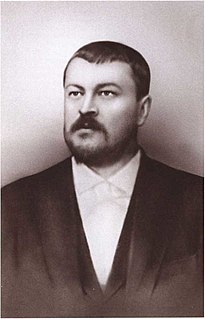
The Russian Revolution of 1905, also known as the First Russian Revolution, was a wave of mass political and social unrest that spread through vast areas of the Russian Empire, some of which was directed at the government. It included worker strikes, peasant unrest, and military mutinies. It led to constitutional reform, including the establishment of the State Duma, the multi-party system, and the Russian Constitution of 1906.

Sergei Vasilyevich Zubatov was a famous Russian police administrator, best known as the advocate of police socialism, which included creating legal, police-controlled trade unions.

Pyotr Nikolayevich Wrangel was a Russian officer of Baltic German origin in the Imperial Russian Army. During the later stages of the Russian Civil War, he was commanding general of the anti-Bolshevik White Army in Southern Russia. After his side lost the civil war in 1920, he left Russia. He was known as one of the most prominent exiled White émigrés and military dictator of the South Russia.

Orekhovo-Zuyevo is an industrial city in Moscow Oblast, Russia, located 85 kilometers (53 mi) east of Moscow in a forested area on the Klyazma River. Orekhovo, often pronounced only as Orekh, is a Russian word which means"nut". The city was established in 1917 when three villages were merged, hence its name. Population: 120,670 (2010 Census); 122,248 (2002 Census); 137,198 (1989 Census).
The Morozovs is a famous Old Believers Russian family of merchants and entrepreneurs. The family name Morozov originates from a Russian word moroz (мороз) that means frost. The founder of the family was Savva Vasilyevich Morozov (1770–1862). He had five sons and a daughter, Varvara Savvichna Morozova.

Nikolskoye is a town in Tosnensky District of Leningrad Oblast, Russia, located on the Tosna River 40 kilometers (25 mi) southeast of the center of St. Petersburg. Population: 19,280 (2010 Census); 17,309 (2002 Census); 17,215 (1989 Census).

Erivan Governorate was one of the guberniyas of the Caucasus Viceroyalty of the Russian Empire, with its centеr in Erivan. Its area was 27,830 sq. kilometеrs. It roughly corresponded to what is now most of central Armenia, the Iğdır Province of Turkey, and the Nakhichevan exclave of Azerbaijan. At the end of the 19th century, it bordered the Tiflis Governorate to the north, the Elisabethpol Governorate to the east, the Kars Oblast to the west, and Persia and the Ottoman Empire to the south. The Mount Ararat and the entire Ararat Valley were in the center of the state.

Vladimir Viktorovich Sakharov was a Russian general of the cavalry who served in the Russian Imperial Army. In an army career lasting from 1869 to 1917, he served in the Russo-Turkish War of 1877-1878, the Russo-Japanese War, and World War I.

Baron Johann Ludwig von Knoop was a cotton merchant and entrepreneur from the city-state Free Hanseatic City of Bremen, who became one of the richest entrepreneurs in his time. He was created a Baron by Alexander II of Russia in 1877.

Savva Timofeyevich Morozov was a Russian textile magnate and philanthropist. Established by Savva Vasilyevich Morozov (1770–1862), the Morozov family was the fifth-richest in Russia at the beginning of the 20th century.

The Soviet city of Taganrog, now part of the Rostov Oblast of the Russian Federation, had an eventful history during World War II, from 1941 to 1945.

Tver Governorate was an administrative division of the Russian Empire and Russian SFSR, which existed from 1796 until 1929. Its seat was in Tver. The governorate was located in the center of the European part of the Russian Empire and bordered Novgorod Governorate in the north, Yaroslavl Governorate in the east, Vladimir Governorate in the southeast, Moscow Governorate in the south, Smolensk Governorate in the southwest, and Pskov Governorate in the west.

The St. Petersburg League of Struggle for the Emancipation of the Working Class was a Marxist group in the Russian Empire. It was founded in St. Petersburg by Vladimir Lenin, Julius Martov, Gleb Krzhizhanovsky, Anatoly Vaneyev, Alexander Malchenko, P. Zaporozhets, V. Starkov and others in the autumn of 1895. It united twenty different Marxist study circles, but Lenin dominated the league through the 'central group'. Its main activity was agitation amongst the workers of St Petersburg and the distribution of socialist leaflets to the factories there.

Isaak Khristoforovich Lalayants was a Russian revolutionary, Marxist, Bolshevik and comrade-in-arms of Vladimir Lenin.
Industrialization in the Russian Empire saw the development of an industrial economy, whereby labor productivity increased and the demand for industrial goods was partially provided from within the empire. Industrialization in the Russian Empire was a reaction to the industrialization process in Western European countries.

Savva Vasilyevich Morozov was an eighteenth-century Russian entrepreneur, who founded the Morozov dynasty.

Clement Joseph Charnock was an English mechanical engineer who spent much of his career in Imperial Russia and is credited with being a pioneer of football in Russia. He followed his elder brother, James Charnock who had left for Russia in 1868, when Clement was three. Another brother, Harry Charnock, also joined them in Russia.

Zuevo was a historic village in Bogorodsky Uyezd, Moscow Governorate, Imperial Russia. It was the administrative centre of Zuevskaya volost. Since 1917 it has been part of the city of Orekhovo-Zuyevo. It was the birthplace of Savva Vasilyevich Morozov and Semyon Grigorievich Zimin, both peasants who became industrialists ensuring Zuevo play an important role in the industrialisation of Imperial Russia.
James Charnock was an English mechanical engineer who spent much of his career in Imperial Russia. His brothers Clement Charnock and Harry Charnock joined him in Russia.

Orekhovo was a village located in Kudykinskaya volost, Pokrovsky Uyezd, Vladimir Governorate, Imperial Russia. Since 1917 it has been part of the city of Orekhovo-Zuyevo. The town played a significant part in the development of the textile sector in Imperial Russia and football in Imperial Russia. The village developed close to Nikolskoye which had been developed as a mill town by the Morozov dynasty.

















